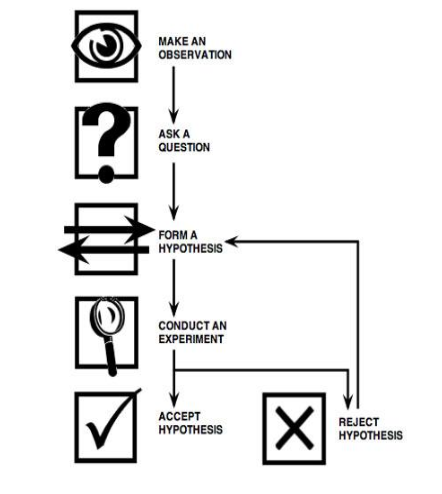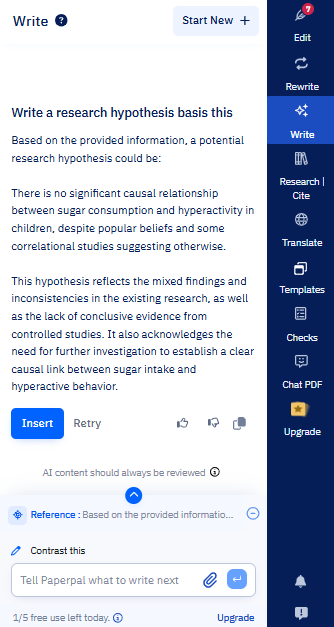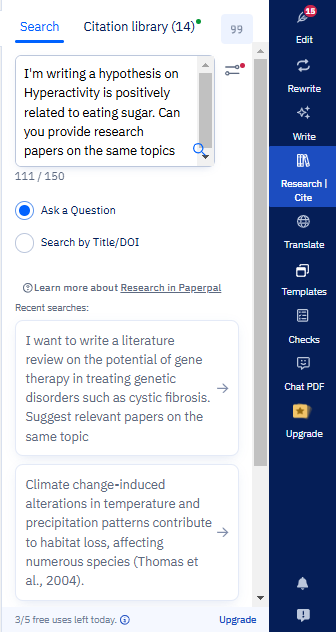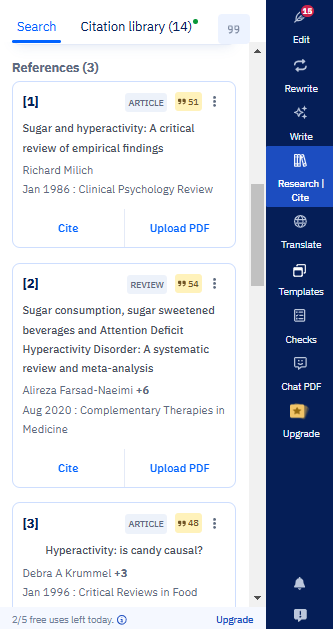Table of Contents
All research studies involve the use of the scientific method, which is a mathematical and experimental technique used to conduct experiments by developing and testing a hypothesis or a prediction about an outcome. Simply put, a hypothesis is a suggested solution to a problem. It includes elements that are expressed in terms of relationships with each other to explain a condition or an assumption that hasn’t been verified using facts.1 The typical steps in a scientific method include developing such a hypothesis, testing it through various methods, and then modifying it based on the outcomes of the experiments.
A research hypothesis can be defined as a specific, testable prediction about the anticipated results of a study.2 Hypotheses help guide the research process and supplement the aim of the study. After several rounds of testing, hypotheses can help develop scientific theories.3 Hypotheses are often written as if-then statements.
Here are two hypothesis examples:
- Dandelions growing in nitrogen-rich soils for two weeks develop larger leaves than those in nitrogen-poor soils because nitrogen stimulates vegetative growth.4
- If a company offers flexible work hours, then their employees will be happier at work.5
What is a Hypothesis?
A hypothesis expresses an expected relationship between variables in a study and is developed before conducting any research. Hypotheses are not opinions but rather are expected relationships based on facts and observations. They help support scientific research and expand existing knowledge.
An incorrectly formulated hypothesis can affect the entire experiment leading to errors in the results so it’s important to know how to formulate a hypothesis and develop it carefully. A few sources of a hypothesis include observations from prior studies, current research and experiences, competitors, scientific theories, and general conditions that can influence people.

Figure 1 depicts the different steps in a research design and shows where exactly in the process a hypothesis is developed.[4]
There are seven different types of hypotheses—simple, complex, directional, nondirectional, associative and causal, null, and alternative.
Types of Hypotheses
The seven types of hypotheses are listed below: [5], [6]
- Simple: Predicts the relationship between a single dependent variable and a single independent variable. For example, “Exercising in the morning every day will increase your productivity.
- Complex: Predicts the relationship between two or more variables. For example, “Spending three hours or more on social media daily will negatively affect children’s mental health and productivity, more than that of adults.”
- Directional: Specifies the expected direction to be followed and uses terms like increase, decrease, positive, negative, more, or less. For example, “The inclusion of intervention X decreases infant mortality compared to the original treatment.”
- Non-directional: Does not predict the exact direction, nature, or magnitude of the relationship between two variables but rather states the existence of a relationship. This hypothesis may be used when there is no underlying theory or if findings contradict prior research. For example, “Cats and dogs differ in the amount of affection they express.
- Associative and causal: An associative hypothesis suggests an interdependency between variables, that is, how a change in one variable changes the other. For example, “There is a positive association between physical activity levels and overall health.” A causal hypothesis, on the other hand, expresses a cause-and-effect association between variables. For example, “Long-term alcohol use causes liver damage.”
- Null: Claims that the original hypothesis is false by showing that there is no relationship between the variables. For example, “Sleep duration does not have any effect on productivity.”
- Alternative: States the opposite of the null hypothesis, that is, a relationship exists between two variables. For example, “Sleep duration affects productivity.”
Characteristics of a Hypothesis
So, what makes a good hypothesis? Here are some important characteristics of a hypothesis.[8], [9]
- Testable: You must be able to test the hypothesis using scientific methods to either accept or reject the prediction.
- Falsifiable: It should be possible to collect data that reject rather than support the hypothesis.
- Logical: Hypotheses shouldn’t be a random guess but rather should be based on previous theories, observations, prior research, and logical reasoning.
- Positive: The hypothesis statement about the existence of an association should be positive, that is, it should not suggest that an association does not exist. Therefore, the language used and knowing how to phrase a hypothesis is very important.
- Clear and accurate: The language used should be easily comprehensible and use correct terminology.
- Relevant: The hypothesis should be relevant and specific to the research question.
- Structure: Should include all the elements that make a good hypothesis: variables, relationship, and outcome.
Functions of a Hypothesis
The following list mentions some important functions of a hypothesis: [1]
- Maintains the direction and progress of the research.
- Expresses the important assumptions underlying the proposition in a single statement.
- Establishes a suitable context for researchers to begin their investigation and for readers who are referring to the final report.
- Provides an explanation for the occurrence of a specific phenomenon.
- Ensures selection of appropriate and accurate facts necessary and relevant to the research subject.
To summarize, a hypothesis provides the conceptual elements that complete the known data, conceptual relationships that systematize unordered elements, and conceptual meanings and interpretations that explain the unknown phenomena. [1]
How to Write a Hypothesis with Paperpal?
Listed below are the main steps explaining how to write a hypothesis.[2], [4], [5]
1. Make an observation and identify variables
Observe the subject in question and try to recognize a pattern or a relationship between the variables involved. This step provides essential background information to begin your research. For example, if you notice that an office’s vending machine frequently runs out of a specific snack, you may predict that more people in the office choose that snack over another.
2. Identify the main research question
After identifying a subject and recognizing a pattern, the next step is to ask a question that your hypothesis will answer. For example, after observing employees’ break times at work, you could ask “why do more employees take breaks in the morning rather than in the afternoon?”
3. Conduct some preliminary research to ensure originality and novelty
Your initial answer, which is your hypothesis, to the question is based on some pre-existing information about the subject. However, to ensure that your hypothesis has not been asked before or that it has been asked but rejected by other researchers you would need to gather additional information. For example, based on your observations you might state a hypothesis that employees work more efficiently when the air conditioning in the office is set at a lower temperature. However, during your preliminary research you find that this hypothesis was proven incorrect by a prior study.
With Paperpal’s Research feature, you can browse theories, and previous studies from 250M+ research articles and gather evidence to prepare a research methodology to carry out your experiments. Here’s how you can conduct a preliminary research with Paperpal
- Search for theories and previous studies with Paperpal’s Research Feature
- Get a detailed summary with relevant research papers to go through
Try Paperpal’s Research Feature
4. Develop a general statement
After your preliminary research has confirmed the originality of your proposed answer, draft a general statement that includes all variables, subjects, and predicted outcome. The statement could be if/then or declarative.
Paperpal’s Write feature can help you develop a hypothesis based on your research question and data. All you need to is add your research question and data to the web editor or upload as a document and tell Paperpal what to write. Basis the results, you can customize your prompts to get tailored results or just brainstorm with AI. 
5. Finalize the hypothesis statement
Use the PICOT model, which clarifies how to word a hypothesis effectively, when finalizing the statement. This model lists the important components required to write a hypothesis.
- Population: The specific group or individual who is the main subject of the research
- Interest: The main concern of the study/research question
- Comparison: The main alternative group
- Outcome: The expected results
- Time: Duration of the experiment
Once you’ve finalized your hypothesis statement you would need to conduct experiments to test whether the hypothesis is true or false.
Hypothesis examples
The following table provides examples of different types of hypotheses. [10], [11]
|
Type |
Example |
|
Null |
Hyperactivity is not related to eating sugar. |
|
There is no relationship between height and shoe size. |
|
|
Alternative |
Hyperactivity is positively related to eating sugar. |
|
There is a positive association between height and shoe size. |
|
|
Simple |
Students who eat breakfast perform better in exams than students who don’t eat breakfast. |
|
Reduced screen time improves sleep quality. |
|
|
Complex |
People with high-sugar diet and sedentary activity levels are more likely to develop depression. |
|
Motorists who talk on the phone while driving will be more likely to make errors on a driving course than those who do not talk on the phone. |
|
|
Directional |
As job satisfaction increases, the rate of employee turnover decreases. |
|
Increase in sun exposure increases the risk of skin cancer. |
|
|
Non-directional |
College students will perform differently from elementary school students on a memory task. |
|
Advertising exposure correlates with variations in purchase decisions among consumers. |
|
|
Associative |
Hospitals have more sick people in them than other institutions in society. |
|
Watching TV is related to increased snacking. |
|
|
Causal |
Inadequate sleep decreases memory retention. |
|
Recreational drugs cause psychosis. |
Key takeaways
Here’s a summary of all the key points discussed in this article about how to write a hypothesis.
- A hypothesis is an assumption about an association between variables made based on limited evidence, which should be tested.
- A hypothesis has four parts—the research question, independent variable, dependent variable, and the proposed relationship between the variables.
- The statement should be clear, concise, testable, logical, and falsifiable.
- There are seven types of hypotheses—simple, complex, directional, non-directional, associative and causal, null, and alternative.
- A hypothesis provides a focus and direction for the research to progress.
- A hypothesis plays an important role in the scientific method by helping to create an appropriate experimental design.
Frequently Asked Questions
References
- Dalen, DVV. The function of hypotheses in research. Proquest website. Accessed April 8, 2024. https://www.proquest.com/docview/1437933010?pq-origsite=gscholar&fromopenview=true&sourcetype=Scholarly%20Journals&imgSeq=1
- McLeod S. Research hypothesis in psychology: Types & examples. SimplyPsychology website. Updated December 13, 2023. Accessed April 9, 2024. https://www.simplypsychology.org/what-is-a-hypotheses.html
- Scientific method. Britannica website. Updated March 14, 2024. Accessed April 9, 2024. https://www.britannica.com/science/scientific-method
- The hypothesis in science writing. Accessed April 10, 2024. https://berks.psu.edu/sites/berks/files/campus/HypothesisHandout_Final.pdf
- How to develop a hypothesis (with elements, types, and examples). Indeed.com website. Updated February 3, 2023. Accessed April 10, 2024. https://www.indeed.com/career-advice/career-development/how-to-write-a-hypothesis
- Types of research hypotheses. Excelsior online writing lab. Accessed April 11, 2024. https://owl.excelsior.edu/research/research-hypotheses/types-of-research-hypotheses/
- What is a research hypothesis: how to write it, types, and examples. Researcher.life website. Published February 8, 2023. Accessed April 11, 2024. https://researcher.life/blog/article/how-to-write-a-research-hypothesis-definition-types-examples/
- Developing a hypothesis. Pressbooks website. Accessed April 12, 2024. https://opentext.wsu.edu/carriecuttler/chapter/developing-a-hypothesis/
- What is and how to write a good hypothesis in research. Elsevier author services website. Accessed April 12, 2024. https://scientific-publishing.webshop.elsevier.com/manuscript-preparation/what-how-write-good-hypothesis-research/
- How to write a great hypothesis. Verywellmind website. Updated March 12, 2023. Accessed April 13, 2024. https://www.verywellmind.com/what-is-a-hypothesis-2795239
- 15 Hypothesis examples. Helpfulprofessor.com Published September 8, 2023. Accessed March 14, 2024. https://helpfulprofessor.com/hypothesis-examples/
- Editage insights. What is the interconnectivity between research objectives and hypothesis? Published February 24, 2021. Accessed April 13, 2024. https://www.editage.com/insights/what-is-the-interconnectivity-between-research-objectives-and-hypothesis
- Understanding null hypothesis testing. BCCampus open publishing. Accessed April 16, 2024. https://opentextbc.ca/researchmethods/chapter/understanding-null-hypothesis-testing/#:~:text=In%20null%20hypothesis%20testing%2C%20this,said%20to%20be%20statistically%20significant
Paperpal is a comprehensive AI writing toolkit that helps students and researchers achieve 2x the writing in half the time. It leverages 22+ years of STM experience and insights from millions of research articles to provide in-depth academic writing, language editing, and submission readiness support to help you write better, faster.
Get accurate academic translations, rewriting support, grammar checks, vocabulary suggestions, and generative AI assistance that delivers human precision at machine speed. Try for free or upgrade to Paperpal Prime starting at US$25 a month to access premium features, including consistency, plagiarism, and 30+ submission readiness checks to help you succeed.
Experience the future of academic writing – Sign up to Paperpal and start writing for free!






